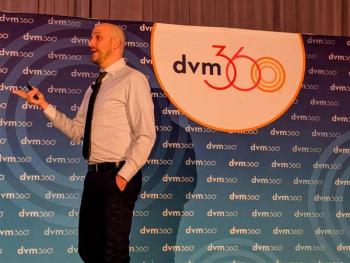
Intestinal tumors--does ultrasonography help (Proceedings)
The main purpose of this presentation is to evaluate the current place of abdominal ultrasonography in assessing intestinal tumors.
The main purpose of this presentation is to evaluate the current place of abdominal ultrasonography in assessing intestinal tumors.
Gastrointestinal neoplasia is often associated with motility disturbances that often produce luminal fluid accumulation, which optimizes visualization of the lesion. The hallmark ultrasonographic sign of intestinal tumor is marked wall thickening associated with complete loss of layering.
The most common ultrasonographic findings of intestinal lymphoma are transmural thickening associated with the diffuse loss of normal wall layering, reduced wall echogenicity, reduced localized motility and regional lymphadenopathy. The thickening of the intestinal wall can widely range from 5 mm to over 25 mm. Jejunal lymphadenopathy is a common finding in intestinal lymphoma and in some instances can be responsible for most of the mid-abdominal mass-effect. Ulcerated lymphoma can be encountered as an irregular mucosal surface or a large defect centered on the affected portion of the GI tract. In cats, alimentary lymphoma has been shown to affect the intestinal tract without fully disrupting the wall layering.
Intestinal carcinomas have been documented in dogs and cats although in our practice, it is encountered less frequently in cats. The most common ultrasonographic findings are transmural thickening with a complete loss of layering that is often associated with lymphadenopathy. In the majority of these cases, there is evidence of fluid accumulation proximal to the intestinal thickening/mass associated with a localized ileus.
Intestinal carcinoma shares some of the ultrasonographic features seen in intestinal lymphoma, but the length of the lesion tends to be shorter in carcinoma than lymphoma, and mechanical ileus is more common in carcinoma than in lymphoma.
Several ultrasonographic features of intestinal smooth muscle tumors or GIST are helpful in differentiating them from other types of GI neoplasia. Leiomyosarcomas are often large (over 3 cm) intramural lesions growing out of the serosa as large eccentric/extraluminal masses. Uncommonly they invade or project into the lumen.
Because of their common exophytic distribution and their large size, it is difficult to assess the anatomical origin of the mass and even more so to determine the precise layer of tumor origin. During real-time evaluation, it is important to identify within the mass any gas and/or the small amount of fluid located in the distorded lumen. Large leiomyosarcomas tend to be heterogeneous with a mixed echogenic pattern. The presence of anechoic and hypoechoic areas within the mass may correlate with the areas of central degeneration and necrosis frequently found in these large lesions.
Other tumors such as histiocytoma/histiocytic sarcoma, mast cell tumor, hemangiosarcoma have been reported. The lesions tend to appear as poorly echogenic masses or focal thickening with loss of layering. No specific ultrasonographic features help in differentiating amongst the different tumors.
Differentiating intestinal tumors from other disorders:
Enteritis may produce different ultrasonographic appearances depending on the localization, duration and severity of the inflammatory condition. Common inflammatory changes such as lymphocytic plasmocytic enteritis can be detected by mild to moderate thickening of one or several intestinal segments. The wall layering is often visible but can be altered in several ways.
The prominent mucosa is unevenly increased in echogenicity, and the demarcation between the mucosa and submucosa may be indistinct. The submucosa can appear thickened and uneven. In some conditions, the muscularis layer is moderately thickened. This may represent an idiopathic hypertrophy of the smooth muscle layer. Mild to moderate regional reactive lymph nodes enlargement is often encountered in inflammatory diseases.
The mean intestinal wall thickness of inflammatory lesions has been reported to be 0.7 +/- 0.4 cm while the intestinal tumors had a mean thickness of 1.9 +/- 1.3 cm (Penninck, 2003).
In severe cases, the wall layering may be lost. Granulomatous enteritis can present as marked wall thickening with lost layering.
Percutaneous ultrasound-guided fine-needle aspirations (22-20 Gauge needle) or automated microcore biopsies (18 Gauge tru-cut biopsy needle) are safe and valid alternative to surgical biopsies to target the lesion and/or the regional lymphadenopathy.
References
Penninck DG, B Smyers , C.R.L. Webster, W. Rand, A. S Moore. Diagnostic value of ultrasonography in differentiating canine enteritis from intestinal neoplasia. Veterinary Radiology & Ultrasound 2003;44:570-575.
Myers, Penninck D.G. Ultrasonographic diagnosis of gastrointestinal smooth muscle tumors in the dog. Vet Radiol & Ultrasound 1993;35:391-397.
Penninck D.G., Crystal M.A., Matz M.E., Pearson S.H. The technique of percutaneous ultrasound guided fine-needle aspiration biopsy and automated microcore biopsy in small animal gastrointestinal diseases. Vet Radiol & Ultrasound 1993;34:433-436.
Crystal M, Penninck DG, Matz M, Pearson S, Freden G and
Jakowski R. Use of ultrasound-guided fine-needle aspiration biopsy and automated microcore biopsy for the diagnosis of gastrointestinal diseases in small animals. Vet Radiology & Ultrasound 1993; 34:438-444.
Penninck D.G., Moore A.S., Tidwell A.S., Matz M.E., Freden G. Ultrasonography of alimentary lymphosarcoma in the cat. Vet Radiol & Ultrasound 1994;35:299-304.
Penninck D.G. Ultrasonographic characterization of gastrointestinal tumors. Vet Clin of N Am 1998;28:777-797.
Grooters AM, Biller DS, Ward H, Miyabayashi T, et al. Ultrasonographic appearance of feline alimentary lymphoma. Veterinary Radiology & Ultrasound 1994; 35:468-472.
Rivers BJ, Walter PA, Johnston GR. Ultrasonographic features of intestinal adenocarcinoma in five cats. Vet Radiol & Ultrasound 1997;38:300-306.
A. L. Zwingenberger, S. L. Marks, T. W. Baker, and P. F. MooreUltrasonographic Evaluation of the Muscularis Propria in Cats with Diffuse Small Intestinal Lymphoma or Inflammatory Bowel Disease J Vet Intern Med 2010;]]:1–4?
Paoloni MC, Penninck DG, Moore AS.Ultrasonographic and clinicopathologic findings in 21 dogs with intestinal adenocarcinoma. Vet Radiol Ultrasound. 2002 Nov-Dec;43(6):562-7.
Laurenson, M>, Skorupski K., Moore P., Zwingenberger A. Ultrasonography of intestinal mast cell tumors in cats. Vet Radiol Ultrasound. 2011 ,52(3):330-334.
Newsletter
From exam room tips to practice management insights, get trusted veterinary news delivered straight to your inbox—subscribe to dvm360.




